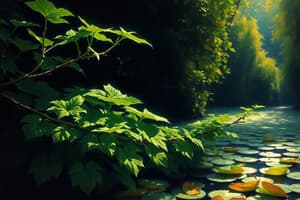Podcast
Questions and Answers
What is the photosynthesis equation?
What is the photosynthesis equation?
- 6 H2O + 6 CO2 = C6H12O6 + 6 O2 (correct)
- 6 CO2 + 6 H2O = C6H12O6 + 6 O2 (correct)
- 6 O2 + C6H12O6 = 6 H2O + 6 CO2
- C6H12O6 + 6 O2 = 6 H2O + 6 CO2
Chloroplasts have two different membranes.
Chloroplasts have two different membranes.
True (A)
Both membranes of a chloroplast are selectively permeable.
Both membranes of a chloroplast are selectively permeable.
True (A)
What are the membranes of a chloroplast made of?
What are the membranes of a chloroplast made of?
What are the reactants of photosynthesis?
What are the reactants of photosynthesis?
The reactants of photosynthesis go _____ the chloroplast.
The reactants of photosynthesis go _____ the chloroplast.
The membranes of the chloroplasts are called...
The membranes of the chloroplasts are called...
Which membrane is more complex and why?
Which membrane is more complex and why?
What is a thylakoid?
What is a thylakoid?
How does the inner membrane become a thylakoid membrane?
How does the inner membrane become a thylakoid membrane?
What is a granum?
What is a granum?
What is the space between the grana called?
What is the space between the grana called?
What are the steps in the middle of photosynthesis called?
What are the steps in the middle of photosynthesis called?
What are the two major steps of photosynthesis?
What are the two major steps of photosynthesis?
Reactants come from...
Reactants come from...
Products come from...
Products come from...
What are the four intermediates?
What are the four intermediates?
What are intermediates?
What are intermediates?
What are the light dependent reactants?
What are the light dependent reactants?
What are the light dependent products?
What are the light dependent products?
What are the light independent reactants?
What are the light independent reactants?
What are the light independent products?
What are the light independent products?
What is another name for the light independent reaction?
What is another name for the light independent reaction?
In what part of the leaf is chlorophyll found in the chloroplasts?
In what part of the leaf is chlorophyll found in the chloroplasts?
Where does most of the water plants use come from?
Where does most of the water plants use come from?
Where is the stomata usually found?
Where is the stomata usually found?
What does a plant use for cellular respiration?
What does a plant use for cellular respiration?
Where does CO2 come from?
Where does CO2 come from?
What does the phloem transport?
What does the phloem transport?
H2O is recycled within the reaction.
H2O is recycled within the reaction.
What is the purpose of photosynthesis?
What is the purpose of photosynthesis?
Why is the epidermis transparent?
Why is the epidermis transparent?
What does chlorophyll do?
What does chlorophyll do?
What is the source of the light reaction?
What is the source of the light reaction?
Which intermediates have the most energy in it?
Which intermediates have the most energy in it?
What is the function of NADPH?
What is the function of NADPH?
Flashcards are hidden until you start studying
Study Notes
Photosynthesis Basics
- Photosynthesis equation: 6 H2O + 6 CO2 = C6H12O6 + 6 O2.
- Balanced equation demonstrates the law of conservation of mass.
Chloroplast Structure
- Chloroplasts possess two membranes: inner and outer.
- Both membranes are selectively permeable, regulating substance passage.
- Membranes are composed of phospholipids and proteins.
- The inner membrane is more complex due to its folding into thylakoid structures.
Thylakoid and Grana
- A thylakoid is a single fold of the thylakoid membrane, crucial for the light-dependent reactions.
- Multiple thylakoids stack to form a granum.
- The stroma is the space surrounding the grana within the chloroplast.
Photosynthesis Processes
- Intermediate steps occur in the process, linking light-dependent and light-independent reactions.
- Major steps of photosynthesis: light-dependent reactions (produce ATP and NADPH) and light-independent reactions (Calvin cycle).
- Reactants for light-dependent reactions include H2O, light, ADP, and NADP+.
- Products of light-dependent reactions are O2, NADPH, and ATP.
Light-Independent Reaction
- Light-independent reactants comprise CO2, NADPH, and ATP, yielding glucose, ADP, and NADP+.
- The Calvin cycle is another term for the light-independent reaction, vital for synthesizing glucose.
Leaf Anatomy and Function
- Chlorophyll is located in the palisade and spongy mesophyll layers, maximizing light absorption.
- Most water used by plants is absorbed from the soil through roots.
- Stomata, primarily located in the upper epidermis, facilitate gas exchange, allowing CO2 to enter and O2 to exit.
Energy and Respiration
- Cellular respiration in plants utilizes oxygen generated from photosynthesis.
- Phloem transports sugars from photosynthesis to other parts of the plant.
Additional Key Points
- Water (H2O) is not recycled in the reactions; only intermediates are reused.
- The goal of photosynthesis is to create glucose and store chemical energy.
- The epidermis of leaves is transparent to permit light penetration for photosynthesis.
- Chlorophyll plays a critical role in capturing light energy and converting it into chemical energy.
- The sun serves as the energy source initiating the light reactions, while ATP and NADPH are high-energy intermediates.
Studying That Suits You
Use AI to generate personalized quizzes and flashcards to suit your learning preferences.




